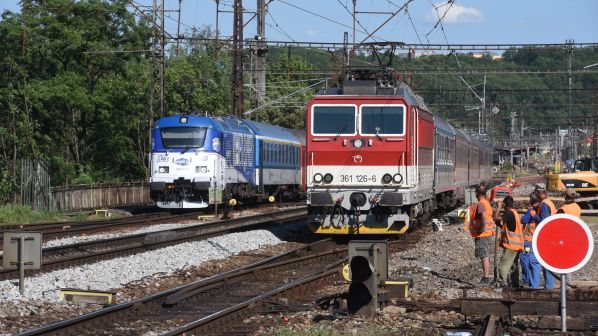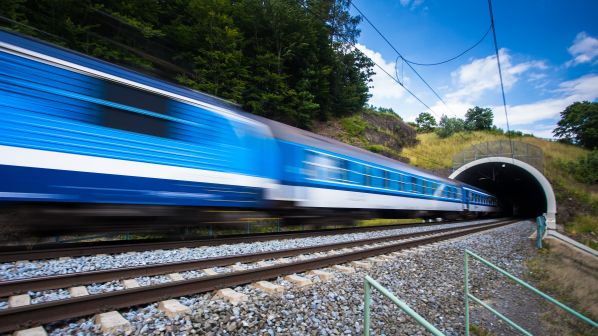THE Czech Republic boasts one of the densest rail networks in the world and with economic growth outstripping the countries of the eurozone, the system is increasingly well-used. Czech Railways (CD), the country’s largest passenger operator, carried a record 179.2 million passengers last year and open-access operators RegioJet and Leo Express reported significant growth as their operations continued to expand.
With the liberalisation of the regional passenger market set to deliver further quality improvements for passengers - and more traffic to the railway - the upward trend looks set to continue.
The capacity challenges facing infrastructure manager SZDC are particularly acute around the capital Prague, where employment growth and soaring house prices have fuelled a rise in commuting. “Many lines in Prague and adjoining areas are already at capacity, or close to reaching it,” explains SZDC CEO Mr Jirí Svoboda. “Therefore SZDC is planning or already implementing the necessary investment in practically all problematic areas.”
The Prague - Benešov u Prahy line is being quadrupled, with significant works now taking place on the Prague Vršovice - Prague Hostivar section. Studies are underway into options for new infrastructure in the heart of the capital to relieve lines feeding into Prague Main Station. “We can assume that this solution will include lines running underground, with a possibility of serving areas of the city that do not currently have direct access to the rail network.”
On the Prague - Pardubice - Ceska Trebova - Ostrava/Brno corridor, traffic has increased significantly in recent years and capacity is now severely constrained. The line is still double track, with a three-track section between Prague and Porícany. This line would be relieved by the proposed Prague - Brno - Breclav high-speed line. In May 2018 SZDC awarded engineering consultancy Sudop a contract to carry out a feasibility study for two potential alignments, one via Havlíckuv Brod and the other via Benešov u Prahy.
Svoboda says a tender will be launched at the end of the year for a contract to draw up planning documentation for the Prague - Porícany, Prerov - Ostrava and Brno - Vranovice high-speed lines, the latter forming part of the corridor from Prague to Breclav, the border station for Austria and Slovakia.
Feasibility study
Tenders will also be launched for planning work on two sections of the Dresden - Prague high-speed line, which will be developed jointly by SZDC and German infrastructure manager DB Network with the support of the German state of Saxony. This concerns the Prague - Lovosice/ Litomerice section and the 26km Erzgebirge Tunnel, which straddles the Czech-German border between Ústi nad Labem and Heidenau on the southern outskirts of Dresden. A feasibility study on the Czech section is due to be completed this month.
“Construction of the first high-speed line in the Czech Republic should start after 2025 and operation should be launched in 2028,” Svoboda says. “This will free up capacity on the currently-congested corridor lines for suburban, regional and freight traffic.”
Cooperation with SNCF will accelerate preparations for building high-speed lines by several years. Jirí Svoboda
French National Railways (SNCF) will support the development of a planning framework for the Czech high-speed network under an agreement signed in April. SNCF will cooperate with SZDC on the creation of a manual which will set parameters for high-speed project planning and the location of worksites. The selection of SNCF was based on the outputs of SZDC’s High-Speed Rail Technical and Operational Study. “Cooperation with SNCF means using French know-how for building high-speed lines in the Czech Republic,” Svoboda says. “France has almost 40 years of experience in high-speed railway construction and operation. Cooperation with SNCF will accelerate preparations for building high-speed lines by several years.
"We need to ensure that the documentation we develop is of a very high quality and that it is discussed in detail with stakeholders to minimise planning risk in the high-speed programme. SZDC is communicating closely with representatives of national and local governments, the public, train operators and the Czech Chamber of Commerce on our high-speed plans.”
Programme of enhancements
In the meantime, SZDC is continuing with a programme of enhancements on existing routes, which will increase capacity and reduce journey times.
In May SZDC awarded a Koruna 3.9bn ($US 170m) contract for the construction of an 8.8km 160km/h double-track line between Sobeslav and Doubí as part of the upgrading of Prague - Ceské Budejovice line. The project will be completed by April 2023, reducing journey times between the two cities by about 15 minutes to around 1h 45min. This leaves only the Ševetín - Nemanice section to be rebuilt.

In April, the Czech Ministry of Finance concluded a Koruna 3bn loan agreement with the European Investment Bank (EIB) to finance upgrading of the Prague - Brno and Prerov - Ostrava - Petrovice u Karviné (Polish border) lines. The two projects represent a combined investment of Koruna 24bn. Tendering is expected to begin at the end of the year, which will enable construction to start in 2020. The Brno - Blazovice stretch of the Brno - Prevrov line will also be upgraded with the maximum speed raised to 200km/h.
Another priority for SZDC is the rollout of ERTMS. This is initially focussing on the TEN-T corridors, which represent around 26% of the network but carry more than 80% of rail traffic in the Czech Republic. These are important routes not just for international and transit traffic but also for domestic freight and passenger services, and the suburban sections of the corridors are particularly congested.
The rollout of ETCS Level 2 began on the Breclav (Austrian border) - Prerov - Ostrava - Bohumín - Petrovice u Karviné (Polish border) corridor in 2016 and trial operation began on the Breclav - Brno - Kolín section at the end of 2018. Other priority routes for ETCS deployment include Kolín - Prague - Kralupy nad Vltavou, Prerov - Ceská Trebová, and Prague - Votice. Work was officially launched on the Prague - Votice ETCS rollout on June 19. SZDC has appointed AZD Praha as contractor for the Koruna 211.3m project, which is being implemented with the aid of Koruna 137.9m in EU structural funding.
“The topic of ETCS implementation became the centre of attention in the Czech Republic after a series of collisions at the beginning of this year,”
In addition to capacity benefits, Svoboda says the migration to ETCS will deliver enhanced safety on an increasingly busy network. “The topic of ETCS implementation became the centre of attention in the Czech Republic after a series of collisions at the beginning of this year,” he says. “The reason in each case was driver error, and the public and politicians therefore started to ask whether ETCS could prevent such accidents. SZDC has made considerable progress with the installation of ETCS. Now it is up to the train operators to start using the system on their side. High costs for the acquisition of onboard equipment present a problem, EU financial support notwithstanding, but we expect that the number of operators interested in testing this system directly on our network will still increase.”
SZDC has been accused of failing to adequately take into account the interests of operators, which suffer disruption during modernisation works, and a lack of transparency in its decision-making. Svoboda says the company is working hard to meet the needs of operators and denies SZDC is taking advantage of its monopoly position. “Although we are a monopoly manager of railway infrastructure in our country, we have never abused this position,” he says. “On the contrary, we have always respected the principle of equal access for all railway undertakings on the SZDC network. Only under such conditions can rail transport prosper.”
With digitalisation and the expansion of infrastructure, SZDC is working to meet the need for greater capacity and enhanced operational performance on an already-busy network. The only question is whether the proposed enhancements can be delivered in time to meet projected demand.

